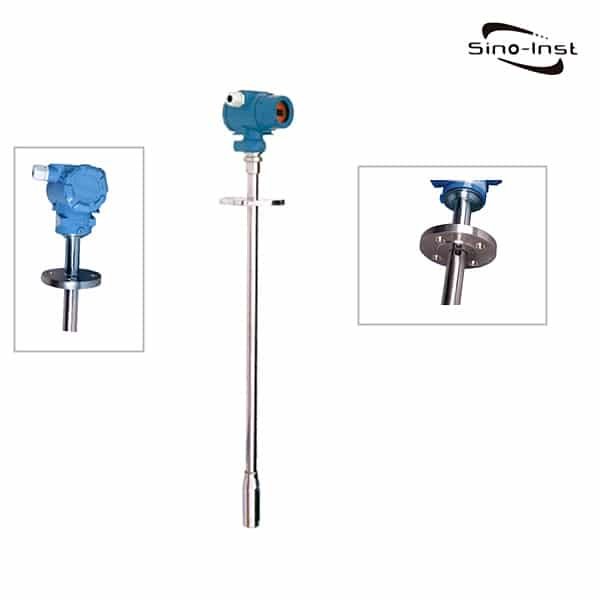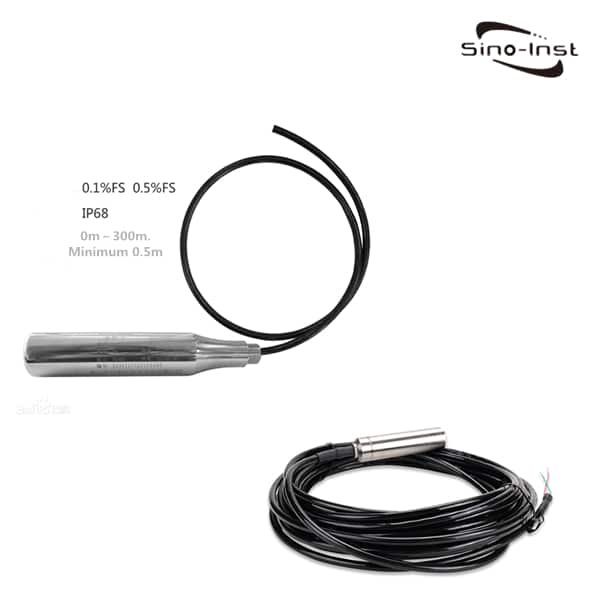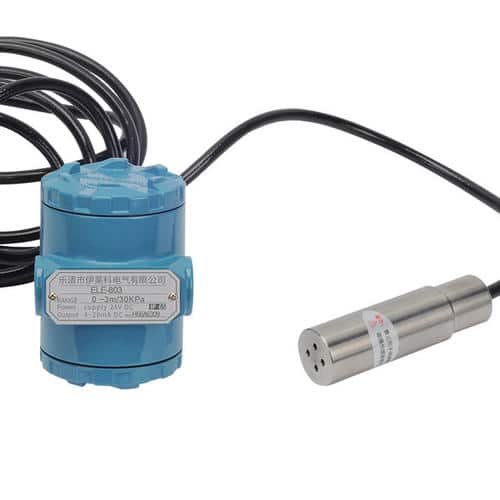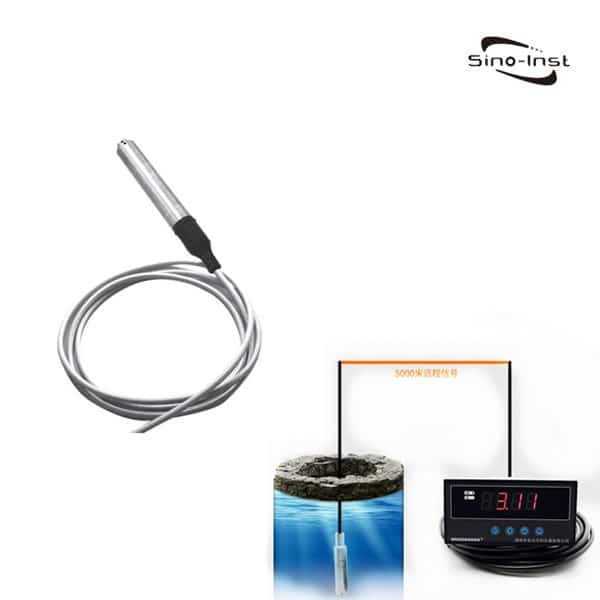Submersible Level Transmitter is made of Anti-corrosive all-tetrafluoroethylene(PTFE) material. It has high temperature resistance, corrosion resistance and anti-clogging.
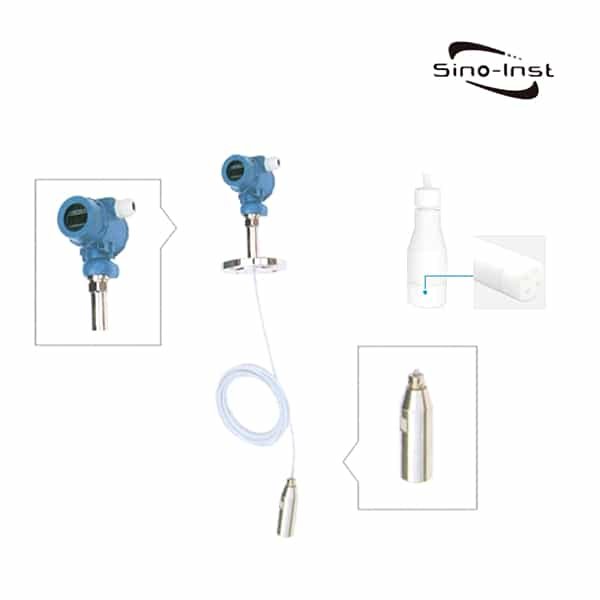
Submersible level transmitter made of PTFE is perfect in the harshest applications. Like Acid and alkali environment, Sludge and Slurries. Anti-corrosive Submersible Level Transmitter utilizes the linear change law of liquid height, density and pressure. It converts the change of liquid level into linear 4-20mADC standard signal output. Integrate temperature compensation calibration technology. Easy installation. Anti-corrosive Submersible Level Transmitter adopts two-wire system. 4 ~ 20mA output. 24V DC power supply. ATEX, 3 wire, remote mount transmitter optional.
Sino-Inst offers a variety of Submersible level transmitters with 4-20mA for industrial level measurement. If you have any questions, please contact our sales engineers.
Features of SI-302 Anti-corrosive Submersible Level Transmitter
- Corrosion resistance, high precision, low cost, high temperature resistance, anti-clogging;
- Convenient installation. Directly put the lowest point of the liquid level of the measured medium. Very convenient to use;
- Solid structure. No moving parts. High reliability. Long service life;
- Widely used to measure the liquid level of any liquid. Except for the medium corrosive to tetrafluoroethylene;
- From water, oil, acid, alkali, salt to paste with high viscosity can be measured with high accuracy. It is not affected by the foaming, deposition and electrical characteristics of the measured medium.
- With power supply reverse polarity and overload current limit protection.
Specifications of Submersible Level Transmitter
| Measuring range: | 0~200m |
| Accuracy: | 0.5 |
| Signal output: | 4~20ADC, 0~20mA |
| Loading resistance: | 0~600Ω |
| Transmitting distance: | >1000m |
| Working voltage: | 24VDC |
| Working temperature: | -50~ +80 °C; -50~ +450 °C; |
| Environmental temperature: | -40~ +50 °C |
| Relative humidity: | ≤85% |
| Contacting liquid material: | Stainless steel, PP, PTFE |
| Installation type: | Flange: DN32 (HG/T20593,20595-97) RF sealing face ; G2″ thread(customize) |
| Electrical connection: | M20×1.5 |
| Explosion-proof grade: | Exia II CT6Ga; Exd II CT6Gb |

Extended reading: sludge blanket level detector
Applications of Anti-corrosive Submersible Level Transmitter
Anti-corrosive Submersible Level Transmitter liquid contact material uses PTFE. Fully sealed welding of stainless steel shell. If customer needs, can be customized full PTFE material. Industry standard 4 ~ 20mA or 0 ~ 10mA signal output. Basically, no maintenance is required, and the wetted part is made of full PTFE material, which is extremely resistant to corrosion.
Anti-corrosive Submersible Level Transmitter is widely used in harshest applications such as Sludge and Slurries.

Product Applications:
Sulfuric acid, hydrochloric acid, hydrofluoric acid;
Corrosive liquids such as liquid alkali, xylene and acetone;
Wastewater;
Sludge pits, clarifiers, digesters;
Alum tanks;
Chemical storage tanks;
Oil tanks;
Lime slurry;
Sumps;
Reservoirs;
Extended reading: Applications of Radar Corrosive Liquid Chemical Level Sensor
How do Submersible Level Transmitters Work?
The basic working principle of Hydrostatic Level Sensor is static pressure level measurement.
In liquid, the pressure generated at a certain depth is generated by the weight of the medium itself above the measurement point. It is proportional to the density of the medium and the local acceleration of gravity.
The formula P = ρgh reflects the proportional relationship between them.
Where P = pressure, ρ = medium density, g = gravity acceleration, h = depth of measurement point.
Therefore, the physical quantity measured by the input liquid level gauge is actually pressure. It can be understood by the calibration unit mH2O of the input level gauge. The actual liquid level must be obtained by conversion after knowing the two parameters of density and gravity acceleration. In the industrial field, such conversion is usually performed by a secondary instrument or PLC.
The Hydrostatic Level Sensor mainly measures corrosive liquids such as hydrochloric acid, hydrogen peroxide, etc. Or chemical and electroplating wastewater. Mainly used in measuring corrosive media. It has the advantages of strong corrosion resistance and stable performance.
More Submersible Pressure Transmitters for level measurement
Submersible Level Transmitter Calibration
Unscrew the protective cover and you will see the zero and full range resistors. External standard power supply and ammeter (above 0.2 level) can be adjusted. Proceed as follows:
- When the transmitter has no liquid. Adjust the zero resistor to make the output current 4mA;
- Transmitter is filled to full scale. Adjust the full range resistor to make it output current 20mA;
- Repeat the above steps two or three times. Until the signal is normal;
- The adjustment is completed. Tighten the protective cover.
Submersible Level Transmitter installation and precautions
The transmitter probe has an M20 × 1.5 interface, which can be screwed directly on the wall of the container or pipeline. Can also put the transmitter into the pool or other liquids. Cable lead to display instrument, secondary instrument or control room. Note that the cable part on the ground needs to be protected or elevated. If there is sediment at the bottom of the liquid to be tested. The transmitter should be raised or filtered for protection.
A. Instructions for installation of input liquid level sensor:
- Sludge and oil residue are easy to deposit on the bottom of the tank. It is recommended to move the measuring probe at a certain height away from the bottom of the tank (cabin). To avoid debris blocking the probe.
- When the medium in the tank fluctuates greatly and the air guide cable is very long. The probe should be fixed with a sleeve. To prevent the probe from swinging and affecting the measurement accuracy.
- When the transmitter is installed, the bending radius of the air guide cable should be greater than 10 cm. Avoid excessive bending to damage the air guide cable.
- The ground terminal of the input liquid level transmitter should be reliably grounded. The power shield should be connected to it.
- The installation direction of the transmitter is vertical. The installation position of the input type (probe) should be far away from the liquid inlet and outlet and the agitator.
- If the medium in the tank has large vibration, wire should be wrapped around the transmitter (probe). Use steel wire to reduce shock to avoid breaking the cable.
B. How to install the input liquid level sensor (probe) to prevent damage to the diaphragm?
When the Submersible Level Transmitter is installed in a stationary deep well or pool. Usually the steel pipe with inner diameter Φ45mm is fixed in water. Make small holes at different heights on the opposite side of the liquid flow direction, so that the medium can enter the tube smoothly. Then put the input liquid level transmitter into the steel pipe and use it.
Learn More About Submersible Level Transducer.
How to use Submersible Level Transmitter ?
- It is best to choose a regulated power supply to supply power separately. The stability of the power supply affects the performance index of the transmitter. It is best to control its error to less than one-fifth of the allowable error of the transmitter. For products with special power supply requirements, special power supplies must be connected.
- The signal cable of the liquid level transmitter should adopt shielded cable. Prevent electromagnetic interference.
- Connect the transmitter according to the correct wiring method. The power-on time should be between 15 and 30 minutes.
- If the liquid level transmitter is installed in the pool, water tower and other occasions. You can sink its probe underwater. Keep away from locations where the water velocity is too fast.
- In the installation of liquid level transmitters with large fluctuations such as submersible pumps, it is best to use the method of inserting steel pipes. The steel pipe should be fixed firmly. A hole should be made in the steel tube at every interval. The position of the steel pipe should be far away from the water inlet and outlet.
- The junction box should be fixed firmly. Or install a fixed bracket. It must be protected from dry and shaded places and must not be exposed to rain.
- Protect the ventilation cable. It must not be bent, blocked or damaged. Extra cables can be coiled nearby.
- The liquid level transmitter installed outdoors must also take lightning protection measures.
Submersible Level Transmitter for Wastewater
The wastewater treatment process involves many occasions where the liquid level needs to be measured. Also due to the characteristics of the sewage treatment process itself. Need to choose the appropriate level sensor according to the characteristics of each process and medium.
The sensor must be suitable for measuring sewage. The acid, alkali and small particles in the sewage have no effect on the measurement accuracy and life. The sensor has high measurement accuracy. Easy to install. Easy to adjust. The level gauge display is intuitive and has analog output and alarm output functions.
Generally speaking, magnetic float level sensor, ultrasonic level sensor and Submersible Level Transmitter can be used to measure the sewage level.
- The magnetic float level sensor is to convert the displacement of the magnetic float with the change of liquid level into a simulated linear standard signal output. The measurement accuracy can generally reach 1.5. When used for sewage measurement, the oil and suspended particles in the sewage will gradually adhere to the wall of the level gauge pipe. Over time, the amount of floating objects increases and the friction increases. The floating ball cannot rise and fall freely as the liquid level changes. It cannot be measured.
- The ultrasonic level sensor is based on the relationship between the distance from the ultrasonic probe to the surface of the measured object and the time. This type of liquid level gauge is almost not limited by the measured medium, but has a blind zone, which is suitable for the level measurement of the large “H” value of the storage silo. For the level measurement of sewage pits, due to the existence of blind areas, it has a greater impact on the accuracy of the measurement.
- Submersible Level Transmitter (cable static pressure liquid level transmitter) uses ceramic or diffused silicon sensors. The sensor goes directly into the measured liquid. The static pressure of the liquid medium directly acts on the sensor diaphragm. The static pressure is proportional to the height of the measured liquid. This level transmitter is small. Easy installation and low cost.
Compare the advantages and disadvantages of the above level gauges. Most customers will choose Submersible Level Transmitter.
Extended reading: Sludge flow meter for sewage treatment return activated sludge system
FAQ
What is hydrostatic level sensor?
Hydrostatic pressure level sensor (Submersible Level Transmitter) is a pressure sensor that measures liquid level based on the principle of static pressure measurement. It can also be called “static pressure liquid level gauge, liquid level transmitter, liquid level sensor, water level sensor”
What is the water level sensor?
The water level sensor is an instrument that can convert the water level parameter of the measured point into the corresponding power signal in real time. It is mainly composed of a fully sealed isolation membrane oil-filled sensor and a built-in high-performance microprocessor.
There are many types of water level sensors. There are three common types of ultrasonic liquid level sensors, servo liquid level sensors and static pressure liquid level sensors. Due to the differences in their working principles and performance, their applications are also different.
What is ultrasonic level sensor?
The ultrasonic level sensor is a non-contact liquid level sensor. Ultrasonic sensors are sensors developed using the characteristics of ultrasound. Ultrasound is a mechanical wave with a vibration frequency higher than that of sound waves, which is generated by the vibration of the transducing wafer under the excitation of voltage. It has high frequency, short wavelength and small diffraction phenomenon. In particular, it has good directivity, and can be ray and directional propagation. Ultrasound has a great ability to penetrate liquids and solids. Especially in the opaque solids of sunlight, it can penetrate a depth of tens of meters.
Sino-Inst offers over 10 Submersible Level Transmitters. About 50% of these are Submersible Level Sensors, 40% are water level meters, and 40% are liquid treatment.
A wide variety of Submersible Level Transmitter options are available to you, such as free samples, paid samples.
Sino-Inst is a globally recognized supplier and manufacturer of Submersible Level Transmitter, located in China.
Sino-Inst sells through a mature distribution network that reaches all 50 states and 30 countries worldwide.
Submersible Level Transmitter products are most popular in Domestic Market, Southeast Asia, and Mid East. You can ensure product safety by selecting from certified suppliers with ISO9001,ISO14001 certification.
Request a Quote

Wu Peng, born in 1980, is a highly respected and accomplished male engineer with extensive experience in the field of automation. With over 20 years of industry experience, Wu has made significant contributions to both academia and engineering projects.
Throughout his career, Wu Peng has participated in numerous national and international engineering projects. Some of his most notable projects include the development of an intelligent control system for oil refineries, the design of a cutting-edge distributed control system for petrochemical plants, and the optimization of control algorithms for natural gas pipelines.

